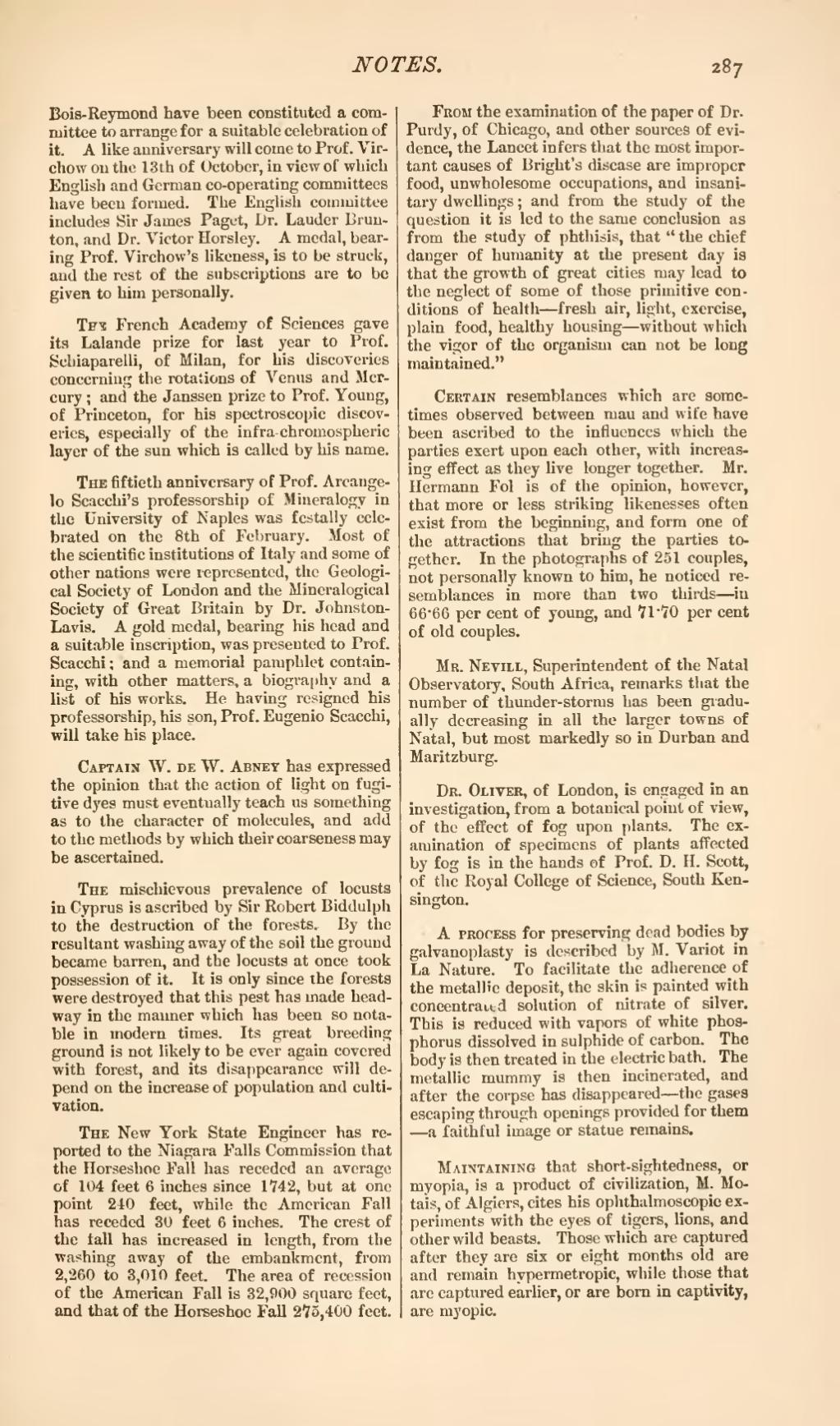Bois-Reymond have been constituted a committee to arrange for a suitable celebration of it. A like anniversary will come to Prof. Vircliow on the 13th of October, in view of which English and German co-operating committees have been formed. The English committee includes Sir James Paget, Dr. Lauder Brunton, and Dr. Victor Horsley. A medal, bearing Prof. Virchow's likeness, is to be struck, and the rest of the subscriptions are to be given to him personally.
The French Academy of Sciences gave its Lalande prize for last year to Prof. Sebiaparelli, of Milan, for his discoveries concerning the rotations of Venus and Mercury; and the Janssen prize to Prof. Young, of Princeton, for his spectroscopic discoveries, especially of the infra-chromospheric layer of the sun which is called by his name.
The fiftieth anniversary of Prof. Arcangelo Scacchi's professorship of Mineralogy in the University of Naples was festally celebrated on the 8th of February. Most of the scientific institutions of Italy and some of other nations were represented, the Geological Society of London and the Mineralogical Society of Great Britain by Dr. JohnstonLavis. A gold medal, bearing his head and a suitable inscription, was presented to Prof. Scacchi; and a memorial pamphlet containing, with other matters, a biography and a list of his works. He having resigned his professorship, his son, Prof. Eugenio Scacchi, will take his place.
Captain W. de W. Abney has expressed the opinion that the action of light on fugitive dyes must eventually teach us something as to the character of molecules, and add to the methods by which their coarseness may be ascertained.
The mischievous prevalence of locusts in Cyprus is ascribed by Sir Robert Biddulph to the destruction of the forests. By the resultant washing away of the soil the ground became barren, and the locusts at once took possession of it. It is only since the forests were destroyed that this pest has made headway in the manner which has been so notable in modern times. Its great breeding ground is not likely to be ever again covered with forest, and its disappearance will depend on the increase of population and cultivation.
The New York State Engineer has reported to the Niagara Falls Commission that the Horseshoe Fall has receded an average of 104 feet 6 inches since 1*742, but at one point 240 feet, while the American Fall has receded 30 feet 6 inches. The crest of the tall has increased in length, from the washing away of the embankment, from 2,260 to 3,010 feet. The area of recession of the American Fall is 32,900 square feet, and that of the Horseshoe Fall 275,400 feet.
From the examination of the paper of Dr. Purdy, of Chicago, and other sources of evidence, the Lancet infers that the most important causes of Bright's disease are improper food, unwholesome occupations, and insanitary dwellings; and from the study of the question it is led to the same conclusion as from the study of phthisis, that "the chief danger of humanity at the present day is that the growth of great cities may lead to the neglect of some of those primitive conditions of health—fresh air, light, exercise, plain food, healthy housing—without which the vigor of the organism can not be long maintained."
Certain resemblances which are sometimes observed between man and wife have been ascribed to the influences which the parties exert upon each other, with increasing effect as they live longer together. Mr. Hermann Fol is of the opinion, however, that more or less striking likenesses often exist from the beginning, and form one of the attractions that bring the parties together. In the photographs of 251 couples, not personally known to him, he noticed resemblances in more than two thirds—in 66·66 per cent of young, and 71·70 per cent of old couples.
Mr. Nevill, Superintendent of the Natal Observatory, South Africa, remarks that the number of thunder-storms has been gradually decreasing in all the larger towns of Natal, but most markedly so in Durban and Maritzburg.
Dr. Oliver, of London, is engaged in an investigation, from a botanical point of view, of the effect of fog upon plants. The examination of specimens of plants affected by fog is in the hands of Prof. D. H. Scott, of the Royal College of Science, South Kensington.
A process for preserving dead bodies by galvanoplasty is described by M. Variot in La Nature. To facilitate the adherence of the metallic deposit, the skin is painted with concentrated solution of nitrate of silver. This is reduced with vapors of white phosphorus dissolved in sulphide of carbon. The body is then treated in the electric bath. The metallic mummy is then incinerated, and after the corpse has disappeared—the gases escaping through openings provided for them—a faithful image or statue remains.
Maintaining that short-sightedness, or myopia, is a product of civilization, M. Motais, of Algiers, cites his ophthalmoscopic experiments with the eyes of tigers, lions, and other wild beasts. Those which are captured after they are six or eight months old are and remain hypermetropic, while those that are captured earlier, or are born in captivity, are myopic.
